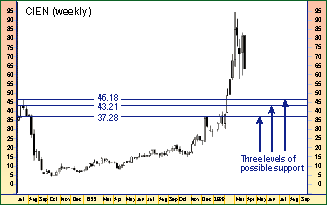Divide And Conquer
The Decomposition Method
by Giorgos Siligardos, Ph.D.
You never know what you might find by studying high, low, and closing prices separately.
In this article, I will introduce the decomposition method of price information, and show how the reverse engineering concept discussed in my previous articles can be expanded to complement this method.
THE IDEA BEHIND DEOMPOSITION
Price data for one day consists of the open, high, low, and close of that particular day. Though these four components are correlated, it can also be useful to study them independently. When the results of most of the isolated analyses agree with the results of the analysis of prices as a whole, you gain more confidence to speculate on a future event. In addition, analyzing high, low, and closing prices independently may be beneficial when you are trying to determine approximately where the next period's high, low, and closing prices will be and consequently determine low-risk buying or selling areas.
INCORPORATING REVERSE ENGINEERING
In my past articles on reverse engineering RSI (see "Related reading"), I showed how the relative strength index indicator introduced by J. Welles Wilder in his book New Concepts In Technical Trading Systems could be used to identify support or resistance levels for the closing price. The Rsi is based on (and controlled only by) one element: the closing price. Wouldn't it be interesting to create an indicator (L) that will be the low price for a period (daily, weekly, and so on) and then create a relative strength indicator (RSIL) based on L?

Figure 1: Weekly chart of CIEN. Three levels of support can be identified using classic analysis.
...Continued in the September issue of Technical Analysis
of STOCKS & COMMODITIES
Excerpted from an article originally published in the September 2004 issue of Technical Analysis of STOCKS & COMMODITIES magazine. All rights reserved. © Copyright 2004, Technical Analysis, Inc.
Return to September 2004 Contents